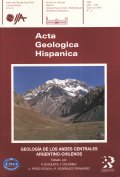Esquema de evolución tectonosedimentaria para las Cuencas Cenozoicas de la Cordillera Oriental (22º a 23º lat. S.), Argentina
Abstract
The structural style of the Eastern Cordillera between 22" and 23" S. L. is the result of stacking of Precambrian sheets. In the Cenozoic, the sedimentary basins were developed under the control of this type of thick skinned structure. The combined study of the regional tectonics, sedimentary Cenozoic deposits and the magmatic arc units allows to present a schematic evolution of the Cenozoic basins. The sedimentary deposits of Pozuelos, Tres Cruces, Santa Victoria Range and Western Subandean Ranges basins are considered.
The Tres Cruces basin presents Cretaceous to Eocene synrift and postrift deposits (Salta Group). They are covered by a Paleogene initial stage of a foreland basin (Lumbrera 11, Casa Grande and Río Grande Formations) and it ends with an overfilling stage during Lower Miocene (Pisungo Formation). At the Pozuelos basin, the Moreta and Cara-Cara Formations represent typical piggyback deposits.
During the Middle to Upper Miocene, the orogenic front migrated towards the east elevating the Sierra de Santa Victoria. The Tres Cruces basin, which was formerly a foreland basin is incorporated to the orogenic system and continued its evolution as a piggyback basin. Consequently, in the subandean area, a new foreland basin was developed, starting with an underfilling stage (Tranquitas Formation and Terciario Subandino Inferior), followed by a prograding sequence (Terciario Subandino Medio) and since the Upper Miocene an overfilling stage was built (Terciario Subandino Superior and Simbolar Formation). An important crustal thickening with an extensive volcanic activity took place in the Puna and part of the Eastem Cordillera during Upper Miocene.


